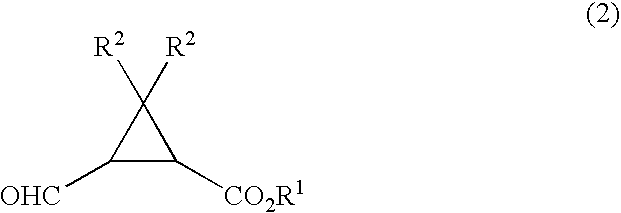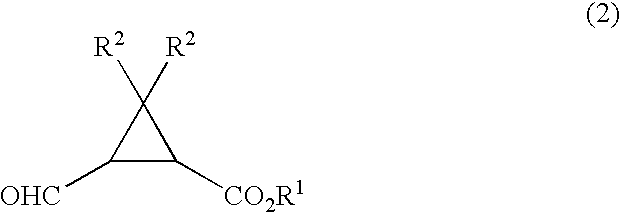Process for production of formylcyclopropanecarboxylic ester
a technology of cyclopropanecarboxylic ester and formylcyclopropanecarboxylate, which is applied in the preparation of carboxylic acid esters, chemistry apparatus and processes, and organic chemistry. temperature control is difficul
- Summary
- Abstract
- Description
- Claims
- Application Information
AI Technical Summary
Benefits of technology
Problems solved by technology
Method used
Image
Examples
example 1
[0069] To a 50 ml Schlenk tube were added 172 mg of ethyl 2,2-dimethyl-3-(hydroxymethyl)cyclopropanecarboxylate, 9.2 g of toluene, 0.18 g of water, 20 mg of dipotassium hydrogenphosphate, and 1.6 mg of 2,2,6,6-tetramethylpiperidine-1-oxyl, and then 931 mg of 12 wt % aqueous sodium hypochlorite was added dropwise thereto under stirring at 20° C. over 2 hrs. After completion of the addition, the reaction solution was maintained under stirring at that temperature for 30 minutes and then 1 ml of aqueous 5 wt % sodium thiosulfate was added thereto and stirred for 5 minutes. After settled, phase separation gave an organic phase containing ethyl 2,2-dimethyl-3-formylcyclopropanecarboxylate.
[0070] Yield: 22%.
example 2
[0071] To a 50 ml Schlenk tube were added 172 mg of ethyl 2,2-dimethyl-3-(hydroxymethyl)cyclopropanecarboxylate, 9.2 g of toluene, 0.18 g of water, 20 mg of potassium dihydrogenphosphate, and 1.6 mg of 2,2,6,6-tetramethylpiperidine-1-oxyl, and then the temperature of the mixture was cooled to 0° C. under stirring. 931 mg of 12 wt % aqueous sodium hypochlorite was added dropwise thereto under stirring over 2 hrs. After completion of the addition, the reaction solution was maintained under stirring at that temperature for 30 minutes and then 1 ml of aqueous 5 wt % sodium thiosulfate was added thereto and stirred for 5 minutes. After settled, phase separation gave an organic phase containing ethyl 2,2-dimethyl-3-formylcyclopropane-carboxylate.
[0072] Yield: 90%.
example 3
[0073] The organic phase containing ethyl 2,2-dimethyl-3-formylcyclopropanecarboxylate was obtained in a similar manner as in Example 2 except that 13 mg of sodium hydrogencarbonate was employed in place of 20 mg of potassium dihydrogenphosphate employed in Example 2.
[0074] Yield: 89%.
PUM
 Login to View More
Login to View More Abstract
Description
Claims
Application Information
 Login to View More
Login to View More - R&D
- Intellectual Property
- Life Sciences
- Materials
- Tech Scout
- Unparalleled Data Quality
- Higher Quality Content
- 60% Fewer Hallucinations
Browse by: Latest US Patents, China's latest patents, Technical Efficacy Thesaurus, Application Domain, Technology Topic, Popular Technical Reports.
© 2025 PatSnap. All rights reserved.Legal|Privacy policy|Modern Slavery Act Transparency Statement|Sitemap|About US| Contact US: help@patsnap.com



